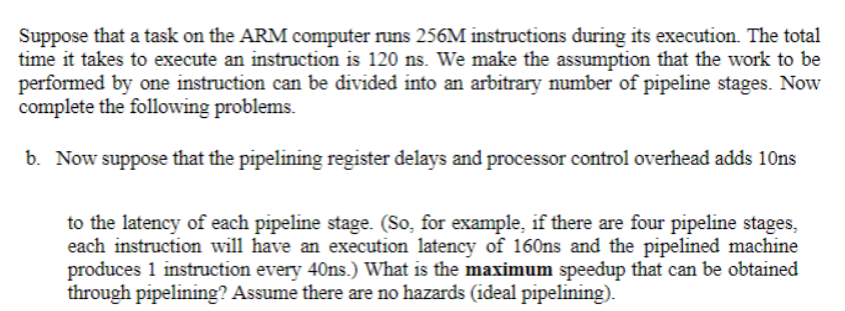Suppose that a task on the ARM computer runs 256M instructions during its execution. The total time it takes to execute an instruction is 120 ns. We make the assumption that the work to be performed by one instruction can be divided into an arbitrary number of pipeline stages. Now complete the following problems. b. Now suppose that the pipelining register delays and processor control overhead adds 10ns to the latency of each pipeline stage. (So, for example, if there are four pipeline stages, each instruction will have an execution latency of 160ns and the pipelined machine produces 1 instruction every 40ns.) What is the maximum speedup that can be obtained through pipelining? Assume there are no hazards (ideal pipelining).
Suppose that a task on the ARM computer runs 256M instructions during its execution. The total time it takes to execute an instruction is 120 ns. We make the assumption that the work to be performed by one instruction can be divided into an arbitrary number of pipeline stages. Now complete the following problems. b. Now suppose that the pipelining register delays and processor control overhead adds 10ns to the latency of each pipeline stage. (So, for example, if there are four pipeline stages, each instruction will have an execution latency of 160ns and the pipelined machine produces 1 instruction every 40ns.) What is the maximum speedup that can be obtained through pipelining? Assume there are no hazards (ideal pipelining).
Computer Networking: A Top-Down Approach (7th Edition)
7th Edition
ISBN:9780133594140
Author:James Kurose, Keith Ross
Publisher:James Kurose, Keith Ross
Chapter1: Computer Networks And The Internet
Section: Chapter Questions
Problem R1RQ: What is the difference between a host and an end system? List several different types of end...
Related questions
Question

Transcribed Image Text:Suppose that a task on the ARM computer runs 256M instructions during its execution. The total
time it takes to execute an instruction is 120 ns. We make the assumption that the work to be
performed by one instruction can be divided into an arbitrary number of pipeline stages. Now
complete the following problems.
b. Now suppose that the pipelining register delays and processor control overhead adds 10ns
to the latency of each pipeline stage. (So, for example, if there are four pipeline stages,
each instruction will have an execution latency of 160ns and the pipelined machine
produces 1 instruction every 40ns.) What is the maximum speedup that can be obtained
through pipelining? Assume there are no hazards (ideal pipelining).
Expert Solution
This question has been solved!
Explore an expertly crafted, step-by-step solution for a thorough understanding of key concepts.
Step by step
Solved in 2 steps

Recommended textbooks for you

Computer Networking: A Top-Down Approach (7th Edi…
Computer Engineering
ISBN:
9780133594140
Author:
James Kurose, Keith Ross
Publisher:
PEARSON

Computer Organization and Design MIPS Edition, Fi…
Computer Engineering
ISBN:
9780124077263
Author:
David A. Patterson, John L. Hennessy
Publisher:
Elsevier Science

Network+ Guide to Networks (MindTap Course List)
Computer Engineering
ISBN:
9781337569330
Author:
Jill West, Tamara Dean, Jean Andrews
Publisher:
Cengage Learning

Computer Networking: A Top-Down Approach (7th Edi…
Computer Engineering
ISBN:
9780133594140
Author:
James Kurose, Keith Ross
Publisher:
PEARSON

Computer Organization and Design MIPS Edition, Fi…
Computer Engineering
ISBN:
9780124077263
Author:
David A. Patterson, John L. Hennessy
Publisher:
Elsevier Science

Network+ Guide to Networks (MindTap Course List)
Computer Engineering
ISBN:
9781337569330
Author:
Jill West, Tamara Dean, Jean Andrews
Publisher:
Cengage Learning

Concepts of Database Management
Computer Engineering
ISBN:
9781337093422
Author:
Joy L. Starks, Philip J. Pratt, Mary Z. Last
Publisher:
Cengage Learning

Prelude to Programming
Computer Engineering
ISBN:
9780133750423
Author:
VENIT, Stewart
Publisher:
Pearson Education

Sc Business Data Communications and Networking, T…
Computer Engineering
ISBN:
9781119368830
Author:
FITZGERALD
Publisher:
WILEY